Optimal Design of Automatic Generation Control Based on Simulated Annealing in Interconnected Two-Area Power System Using Hybrid PID—Fuzzy Control
Abstract
1. Introduction
2. Power System Mathematical Model
2.1. Speed Governor Representation
2.2. Hydraulic Amplifier Representation
2.3. Turbine Representation
2.4. Tie-Line Power Representation
3. Proposed Work
3.1. Tie-Line Bias Control
3.2. Optimum Parameters
3.3. Optimization Algorithm
3.4. Control Techniques
3.4.1. Conventional PID Controller
3.4.2. Fuzzy Logic Controllers
3.4.3. Proposed Hybrid PID–Fuzzy Controller
3.4.4. Rule Base for Fuzzy Logic System
4. Results and Discussion
4.1. Optimum Parameters Tuned
4.2. Case Studies: Frequency and Tie-Line Power Response
- Case 1: the input disturbance is taken as d1 = 0.2 pu and d21 = 0.0;
- Case 2: the input disturbance is taken as d1 = 0.0 pu and d21 = 0.2 pu.
5. Conclusions
Author Contributions
Funding
Institutional Review Board Statement
Informed Consent Statement
Acknowledgments
Conflicts of Interest
References
- Sharma, Y.; Saikia, L.C. Automatic generation control of a multi-area ST—Thermal power system using Grey Wolf Optimizer algorithm based classical controllers. Int. J. Electr. Power Energy Syst. 2015, 73, 853–862. [Google Scholar] [CrossRef]
- Delassi, A.; Arif, S.; Mokrani, L. Load frequency control problem in interconnected power systems using robust fractional PIλ D controller. Ain Shams Eng. J. 2018, 9, 77–88. [Google Scholar] [CrossRef]
- Acharyulu, B.V.S.; Hota, P.K.; Mohanty, B. CLSA-MRPID controller for automatic generation control of a three-area hybrid system. Energy Syst. 2020, 11, 163–194. [Google Scholar] [CrossRef]
- Diggavi, K.C.; Pinnapureddy, R.; Rao, K.J. Analysis of load frequency control for multi area system using PI and fuzzy logic controllers. In Proceedings of the 2017 Second International Conference on Electrical, Computer and Communication Technologies (ICECCT), Coimbatore, India, 22–24 February 2017. [Google Scholar] [CrossRef]
- Roy, R.; Bhatt, P.; Ghoshal, S.P. Evolutionary computation based three-area automatic generation control. Expert Syst. Appl. 2010, 37, 5913–5924. [Google Scholar] [CrossRef]
- Raju, M.; Saikia, L.C.; Sinha, N. Automatic generation control of a multi-area system using ant lion optimizer algorithm based PID plus second order derivative controller. Int. J. Electr. Power Energy Syst. 2016, 80, 52–63. [Google Scholar] [CrossRef]
- Sala, A.; Albertos, P. Fuzzy Logic Controllers: Advantages and Drawbacks. Anales III. 1998. Available online: http://personales.upv.es/asala/publics/papers/c24alca98.pdf (accessed on 11 November 2021).
- Al-Odienat, A.I.; Al-Lawama, A.A. The advantages of PID fuzzy controllers over the conventional types. Am. J. Appl. Sci. 2008, 5, 653–658. [Google Scholar] [CrossRef]
- Bhandari, S.; Sahay, K.B.; Singh, R.K. Optimization Techniques in Modern Times and Their Applications. In Proceedings of the 2018 International Electrical Engineering Congress (iEECON), Krabi, Thailand, 7–9 March 2018. [Google Scholar] [CrossRef]
- Zhang, X.; Yu, T.; Pan, Z.; Yang, B.; Bao, T. Lifelong learning for complementary generation control of interconnected power grids with high-penetration renewable and EVs. IEEE Trans. Power Syst. 2018, 33, 4097–4110. [Google Scholar] [CrossRef]
- Zhang, X.; Xu, Z.; Yu, T.; Yang, B.; Wang, H. Optimal mileage based AGC dispatch of a GenCo. IEEE Trans. Power Syst. 2020, 35, 2516–2526. [Google Scholar] [CrossRef]
- Zhang, X.; Li, Q.; Yu, T.; Yang, B. Consensus transfer Q-learning for decentralized generation command dispatch based on virtual generation tribe. IEEE Trans. Smart Grid 2018, 9, 2152–2165. [Google Scholar] [CrossRef]
- Zhang, X.; Tan, T.; Zhou, B.; Yu, T.; Yang, B.; Huang, X. Adaptive distributed auction-based algorithm for optimal mileage based AGC dispatch with high participation of renewable energy. Int. J. Electr. Power Energy Syst. 2021, 124, 106371. [Google Scholar] [CrossRef]
- Rohini, V.; Natarajan, A.M. Comparison of genetic algorithm with Particle Swarm Optimisation, ant colony optimisation and Tabu search based on university course scheduling system. Indian J. Sci. Technol. 2016, 9. [Google Scholar] [CrossRef][Green Version]
- Magdy, G.; Shabib, G.; Elbaset, A.A.; Mitani, Y. Optimized coordinated control of LFC and SMES to enhance frequency stability of a real multi-source power system considering high renewable energy penetration. Prot. Control Mod. Power Syst. 2018, 3, 39. [Google Scholar] [CrossRef]
- Hota, P.K.; Mohanty, B. Automatic generation control of multi source power generation under deregulated environment. Int. J. Electr. Power Energy Syst. 2016, 75, 205–214. [Google Scholar] [CrossRef]
- Daraz, A.; Malik, S.A.; Mokhlis, H.; Haq, I.U.; Laghari, G.F.; Mansor, N.N. Fitness Dependent Optimizer-Based Automatic Generation Control of Multi-Source Interconnected Power System with Non-Linearities. IEEE Access 2020, 8, 100989–101003. [Google Scholar] [CrossRef]
- Sahu, R.K.; Panda, S.; Rout, U.K.; Sahoo, D.K. Teaching learning based optimization algorithm for automatic generation control of power system using 2-DOF PID controller. Int. J. Electr. Power Energy Syst. 2016, 77, 287–301. [Google Scholar] [CrossRef]
- Ismail, M.M.; Bendary, A.F. Load Frequency Control for Multi Area Smart Grid based on Advanced Control Techniques. Alexandria Eng. J. 2018, 57, 4021–4032. [Google Scholar] [CrossRef]
- Falehi, A.D. Optimal design of fuzzy-AGC based on PSO & RCGA to improve dynamic stability of interconnected multi area power systems. Int. J. Autom. Comput. 2017, 17, 599–609. [Google Scholar] [CrossRef]
- Alzaareer, K.; Al-Shetwi, A.Q.; El-Bayeh, C.Z.; Taha, M.B. Automatic generation control of multi-area interconnected power systems using ANN controller. Rev. D’Intell. Artif. 2020, 34, 1–10. [Google Scholar] [CrossRef]
- Dhillon, S.S.; Lather, J.S.; Marwaha, S. Multi Area Load Frequency Control Using Particle Swarm Optimization and Fuzzy Rules. Procedia Comput. Sci. 2015, 57, 460–472. [Google Scholar] [CrossRef]
- Sahu, R.K.; Rout, U.K.; Panda, S. Automatic generation control of multi-area power system using gravitational search algorithm. In Lecture Notes in Computer Science; 8297 LNCS, no. PART 1; Springer: Cham, Switzerland, 2013. [Google Scholar] [CrossRef]
- Sambariya, D.; Nath, V. Load Frequency Control Using Fuzzy Logic Based Controller for Multi-area Power System. Br. J. Math. Comput. Sci. 2016, 13, 1–19. [Google Scholar] [CrossRef]
- Arya, Y.; Kumar, N. Optimal control strategy–based AGC of electrical power systems: A comparative performance analysis. Optim. Control. Appl. Methods 2017, 38, 982–992. [Google Scholar] [CrossRef]
- Ajithapriyadarsini, S.; Mary, P.M.; Iruthayarajan, M.W. Automatic generation control of a multi-area power system with renewable energy source under deregulated environment: Adaptive fuzzy logic-based differential evolution (DE) algorithm. Soft Comput. 2019, 23, 12087–12101. [Google Scholar] [CrossRef]
- Jagatheesan, K.; Anand, B. Performance analysis of three area thermal power systems with different steam system configurations considering non linearity and boiler dynamics using conventional controller. In Proceedings of the 2015 International Conference on Computer Communication and Informatics (ICCCI), Coimbatore, India, 8–10 January 2015. [Google Scholar] [CrossRef]
- Fathy, A.; Kassem, A.M.; Abdelaziz, A.Y. Optimal design of fuzzy PID controller for deregulated LFC of multi-area power system via mine blast algorithm. Neural Comput. Appl. 2020, 32, 4531–4551. [Google Scholar] [CrossRef]
- Demiroren, A.; Yesil, E. Automatic generation control with fuzzy logic controllers in the power system including SMES units. Int. J. Electr. Power Energy Syst. 2004, 26, 291–305. [Google Scholar] [CrossRef]
- Abo-Elyousr, F.K. Load frequency controller design for two area interconnected power system with DFIG based wind turbine via ant colony algorithm. In Proceedings of the 2016 Eighteenth International Middle East Power Systems Conference (MEPCON), Cairo, Egypt, 27–29 December 2016. [Google Scholar] [CrossRef]
- John, N.; Ramesh, K. Enhancement of Load Frequency Control Considerning High Penetration of Wind Turbine using PSO-Fuzzy Technique. Int. J. Comput. Appl. 2013, 69, 1–7. [Google Scholar] [CrossRef]
- Rakhshani, E.; Rouzbehi, K.; Sadeh, S. A new combined model for simulation of mutual effects between LFC and avr loops. In Proceedings of the 2009 Asia-Pacific Power and Energy Engineering Conference, Wuhan, China, 27–31 March 2009. [Google Scholar] [CrossRef]
- Mishra, E.; Tiwari, S. Comparative Analysis of Fuzzy Logic and PI Controller Based Electronic Load Controller for Self-Excited Induction Generator. Adv. Electr. Eng. 2017, 2017, 5620830. [Google Scholar] [CrossRef]
- Panda, G.; Panda, S.; Cemal, A. Automatic generation control of interconnected power system with generation rate constraints by hybrid neuro fuzzy approach. Int. J. Electr. Electron. Eng. 2009, 6, 471–476. [Google Scholar]
- Saikia, L.C. AGC of a three area thermal system using MLPNN controller: A preliminary study. In Proceedings of the 2012 9th International Conference on Electrical Engineering/Electronics, Computer, Telecommunications and Information Technology, Phetchaburi, Thailand, 16–18 May 2012. [Google Scholar]
- Ahmed, M.; Osman, M.; Magzoub, A.; Salem, A. Load Frequency Control in Two Area Power System using GA, SA and PSO Algorithms: A Comparative Study. In Proceedings of the 2021 31st Australasian Universities Power Engineering Conference (AUPEC), Perth, Australia, 26–30 September 2021. [Google Scholar]
- Saikia, L.C.; Nanda, J.; Mishra, S. Performance comparison of several classical controllers in AGC for multi-area interconnected thermal system. Int. J. Electr. Power Energy Syst. 2011, 33, 394–401. [Google Scholar] [CrossRef]

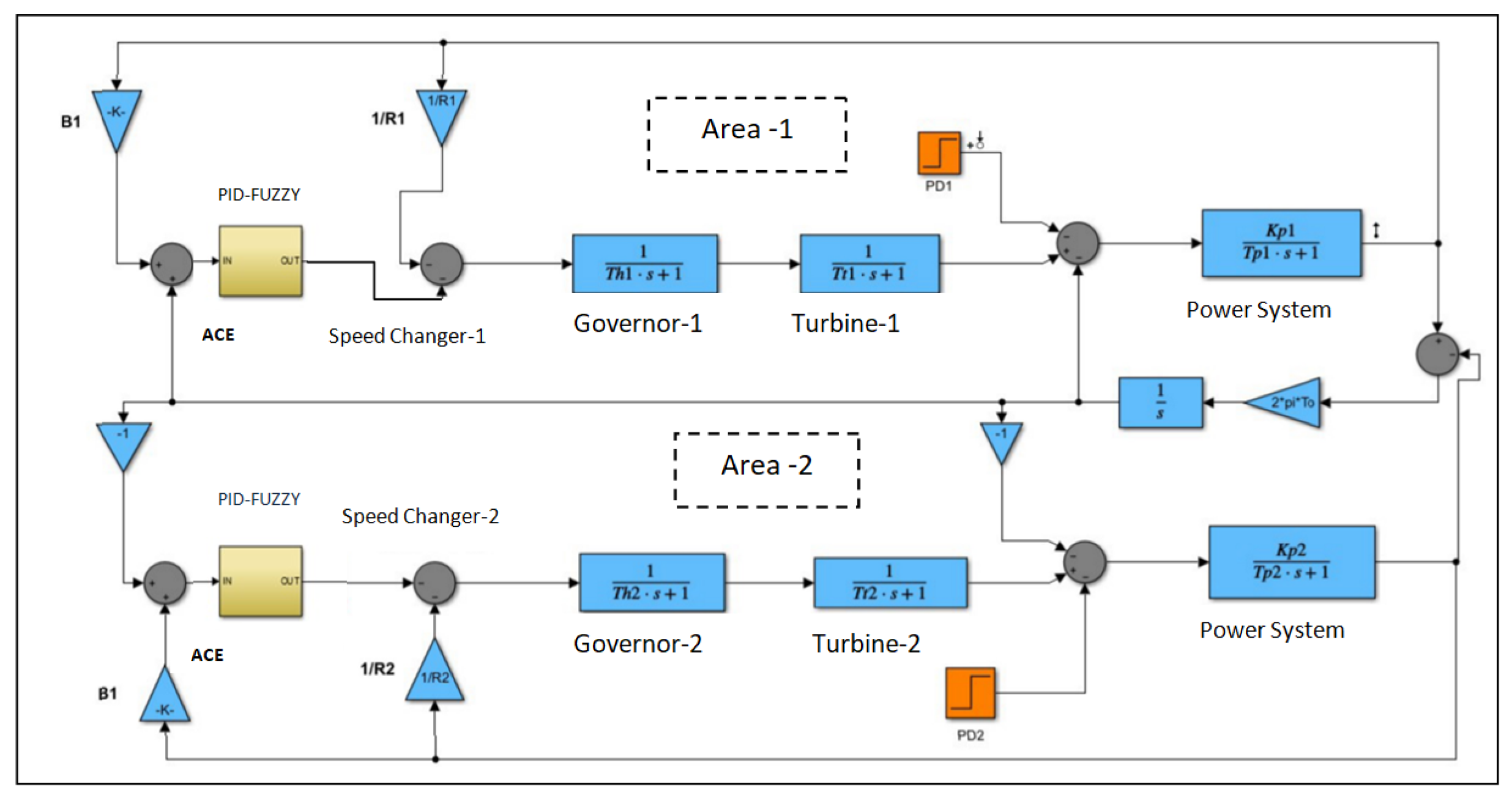


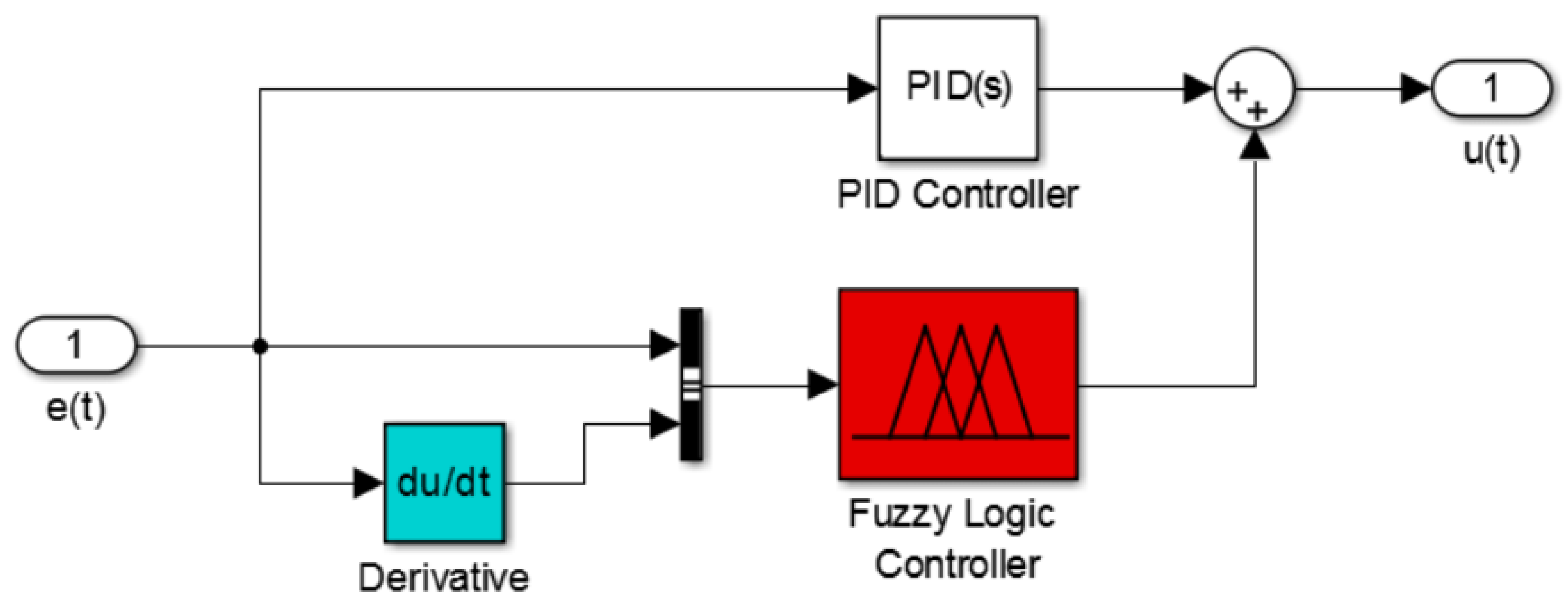
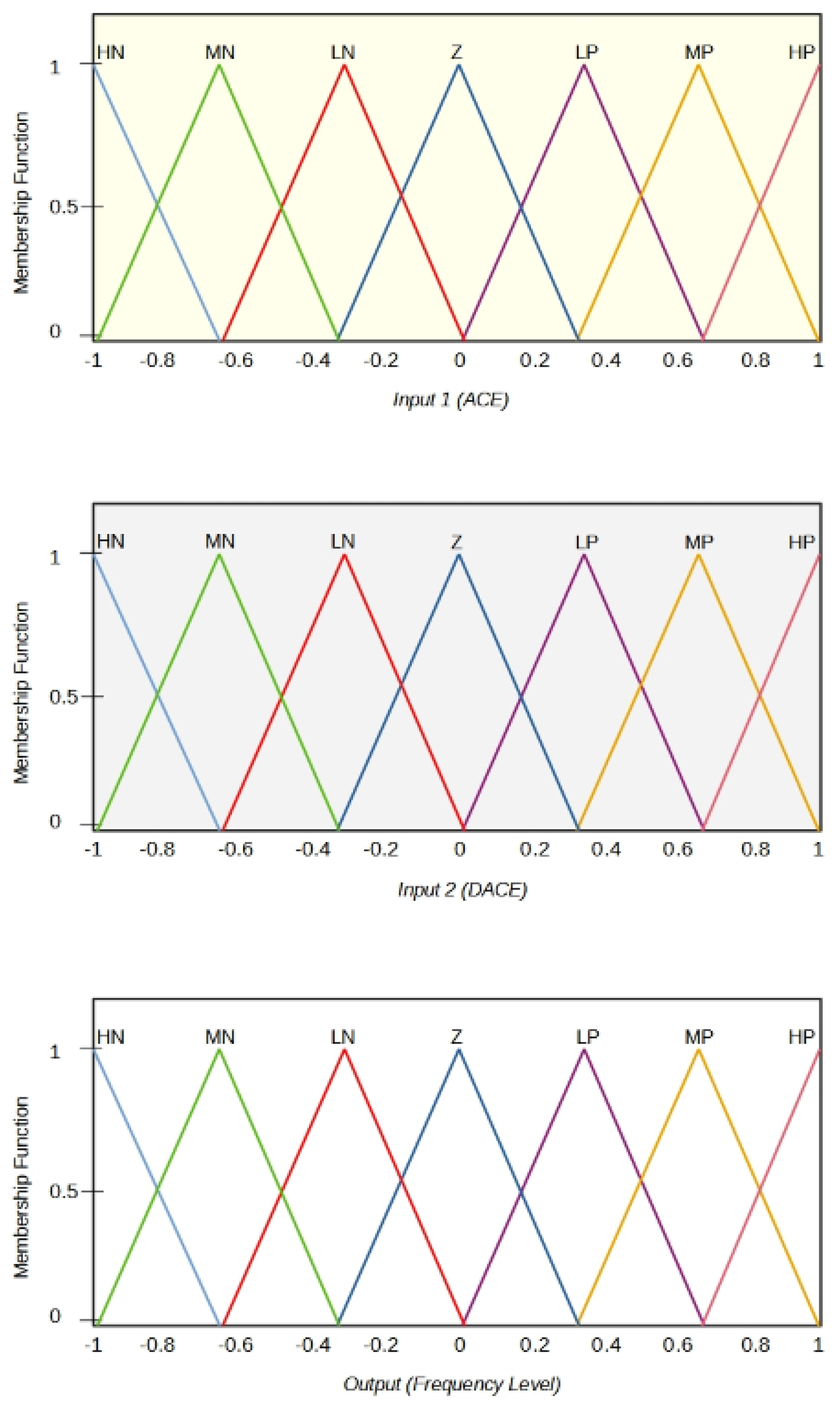
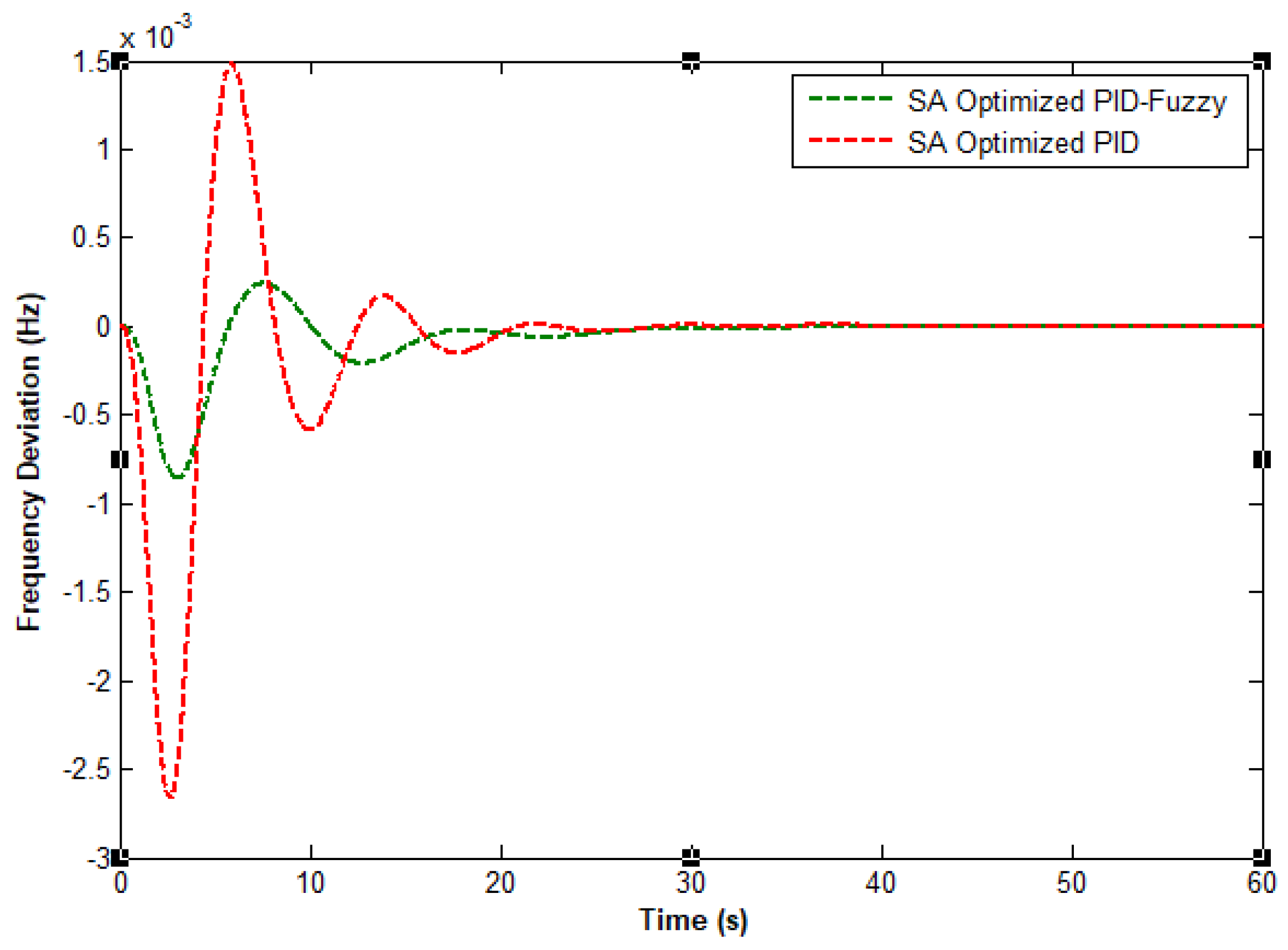
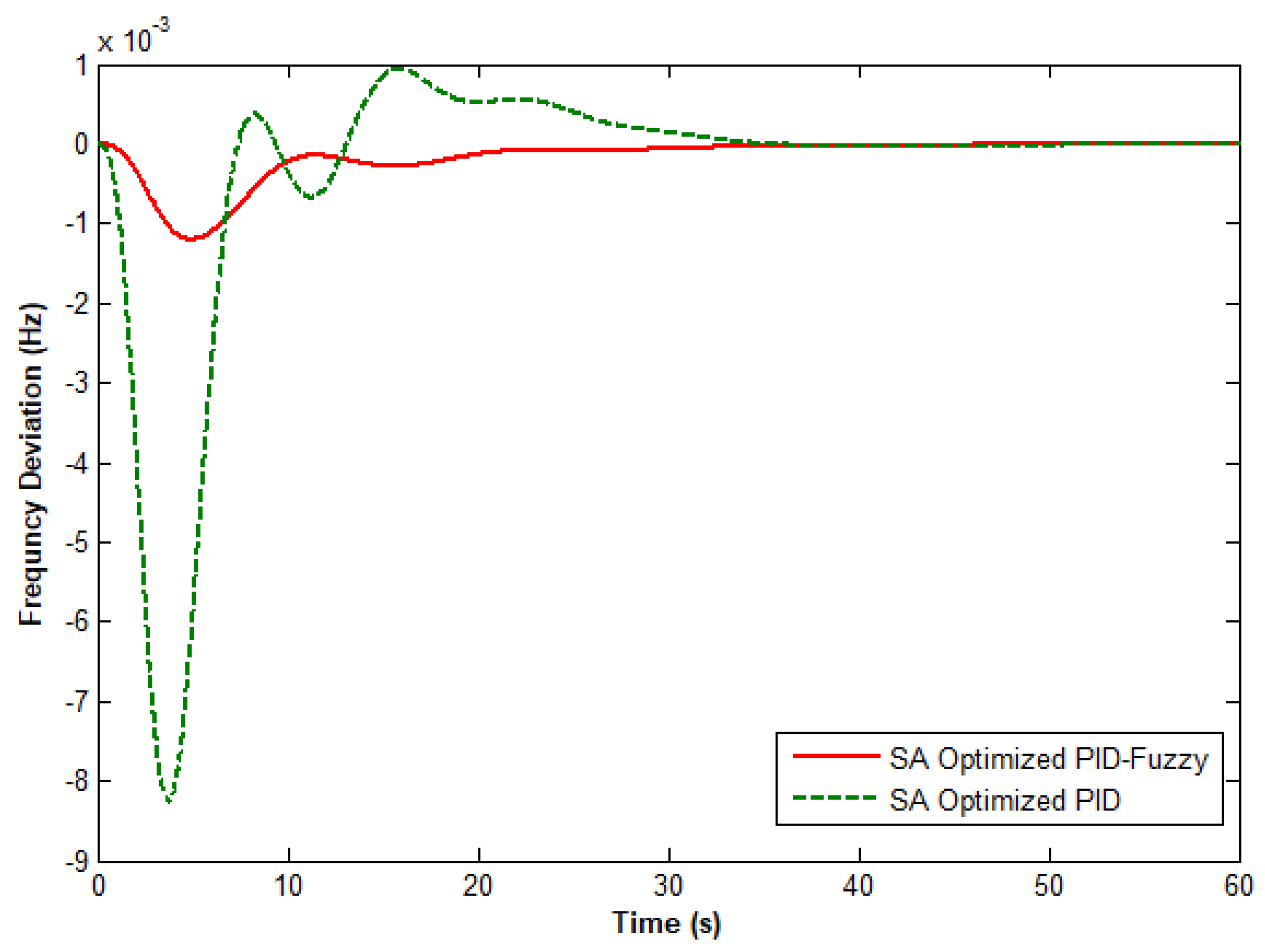
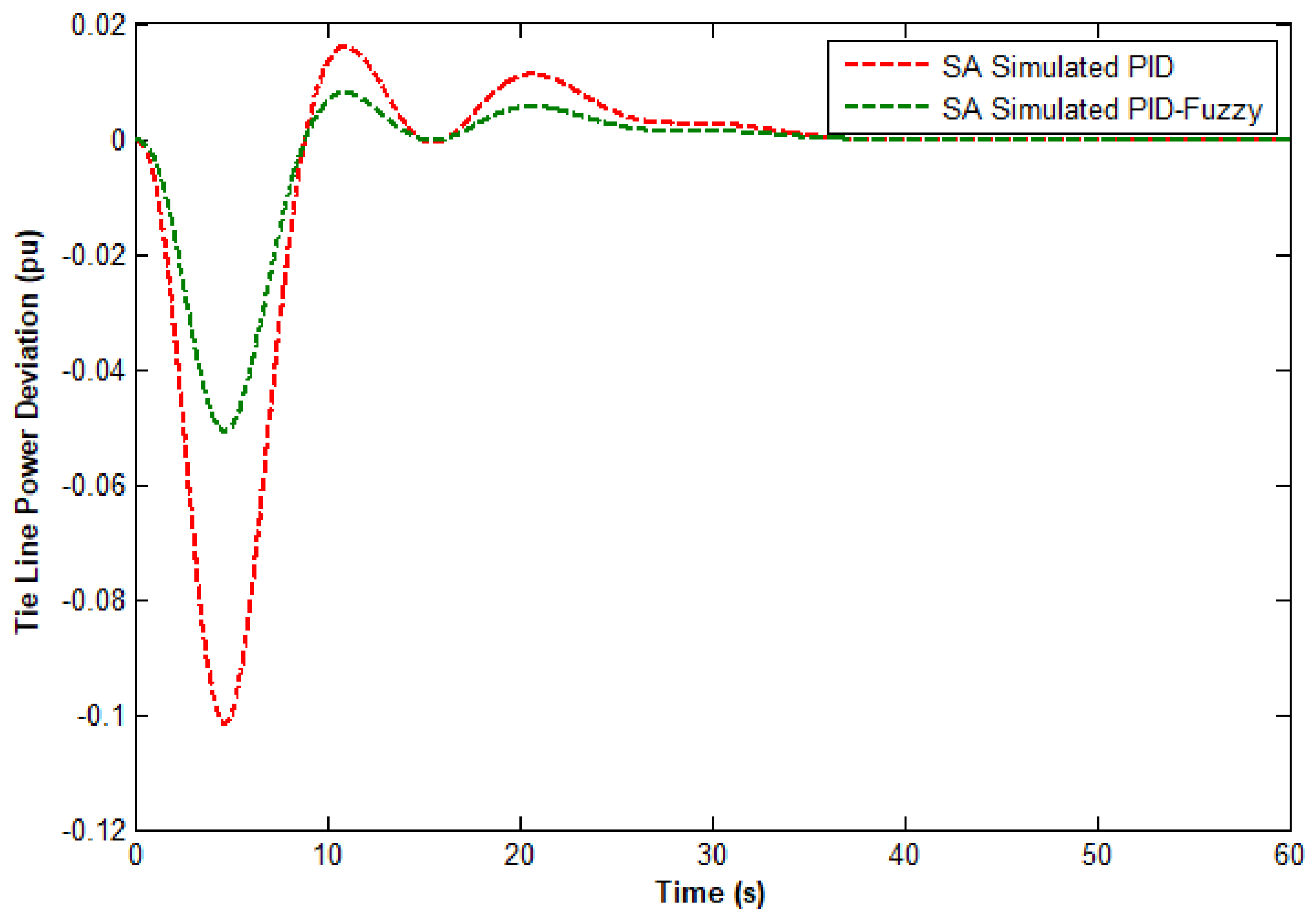
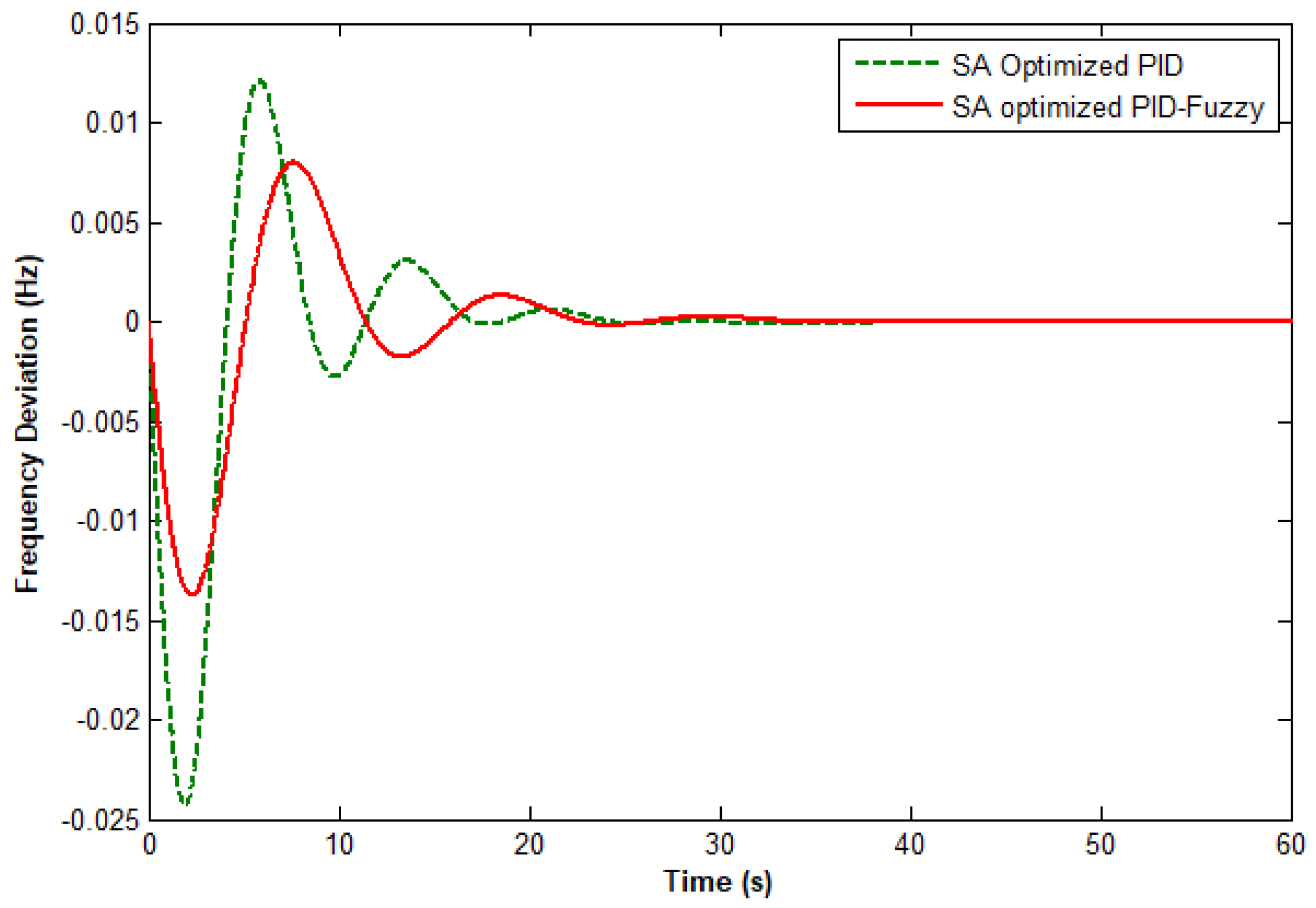
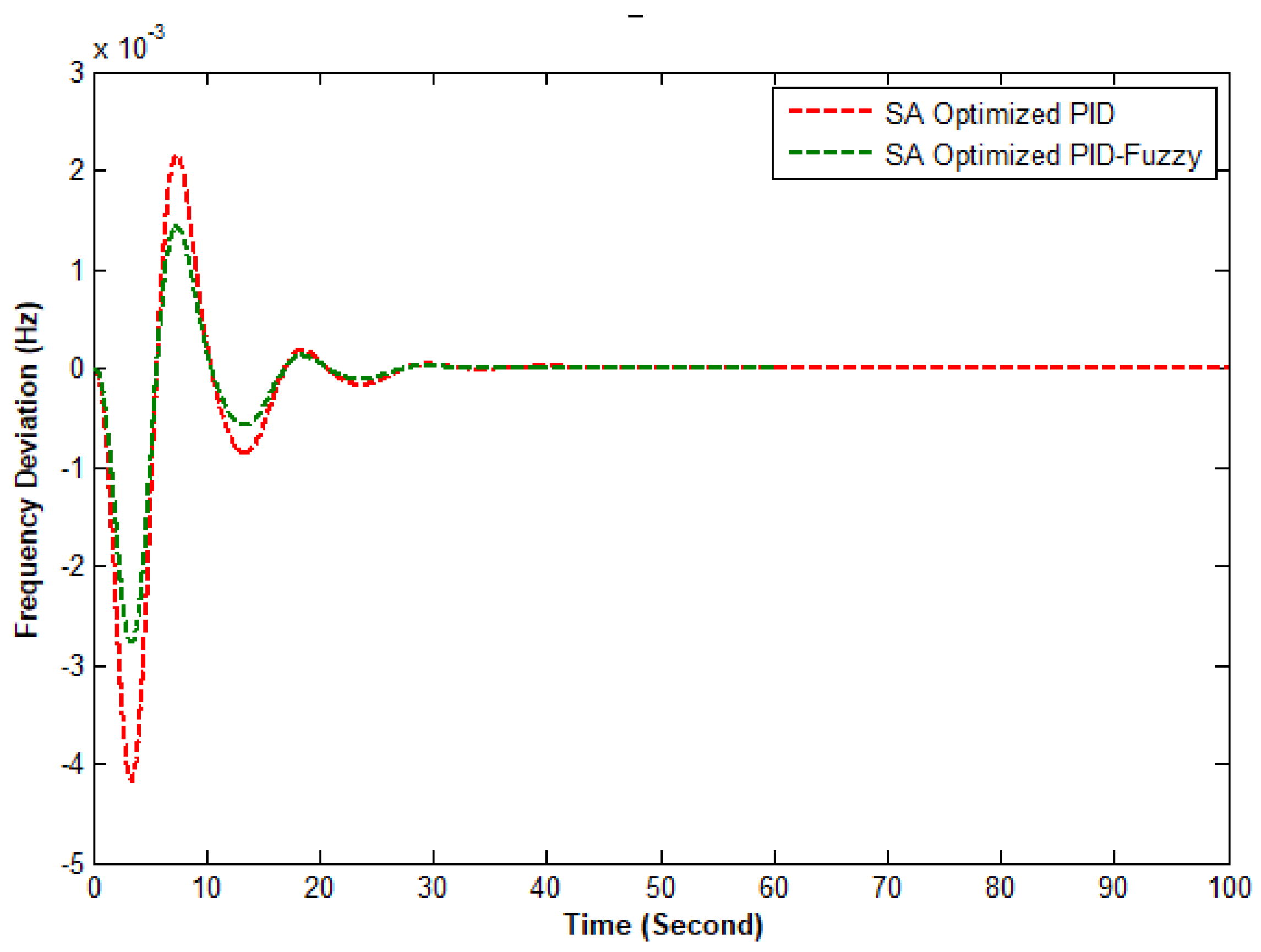
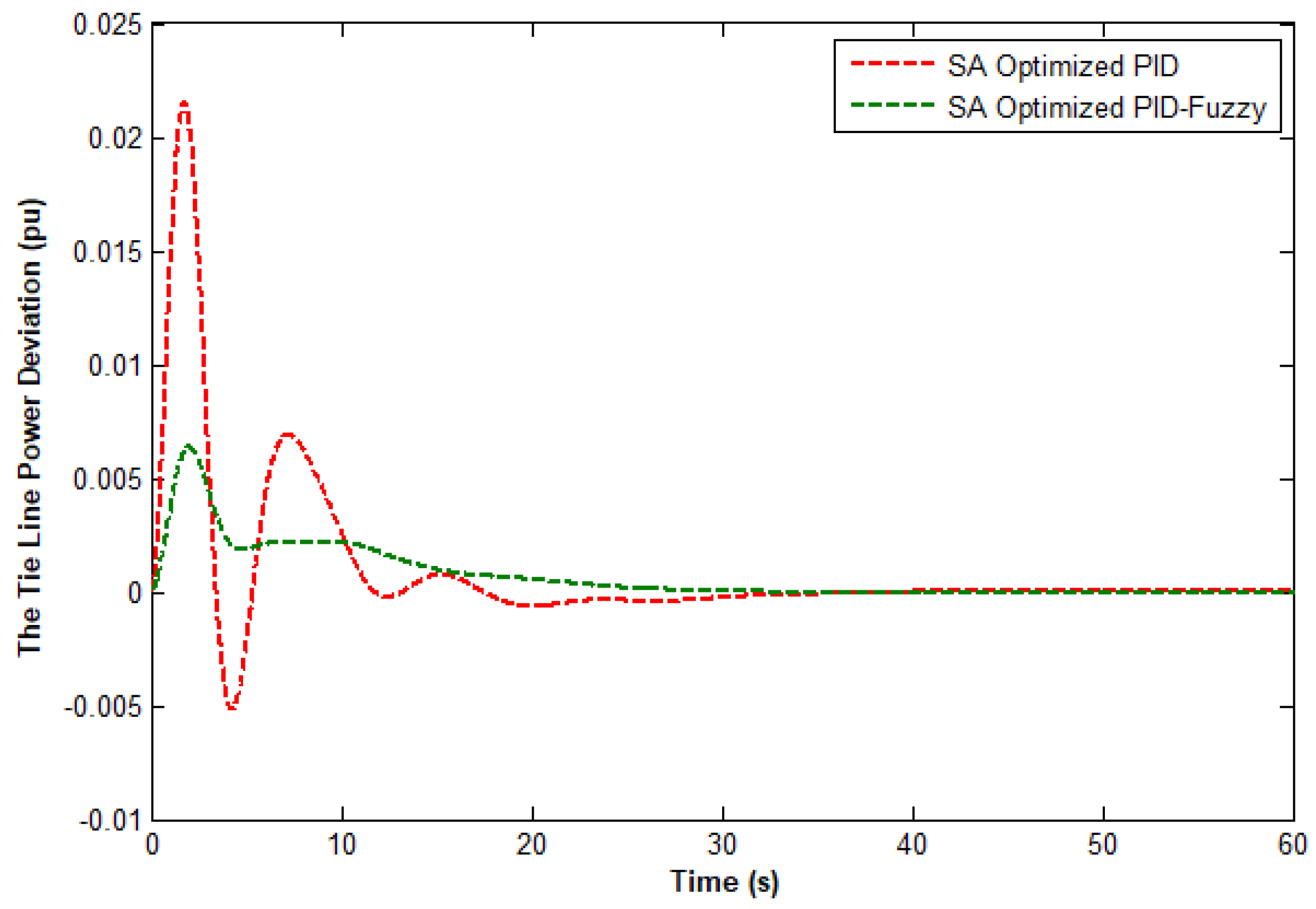
| Max iterations | Inf | Max function evaluations | 12,000 |
| Time limit | Inf | Function tolerance | 1 × 10 |
| Objective limit | Inf | Stall iterations | 2000 |
| Annealing function | Fast annealing | Reannealing interval | 100 |
| ACE | |||||||
|---|---|---|---|---|---|---|---|
| ΔACE | HN | MN | LN | Z | LP | MP | HP |
| HN | HP | HP | HP | MP | MP | LP | Z |
| MN | HP | MP | LP | LP | Z | LN | MN |
| LN | HP | LP | Z | LN | LN | MN | HN |
| Z | MP | MP | LP | Z | LN | MN | MN |
| LP | HP | LP | Z | LN | LN | MN | HN |
| MP | LP | Z | LN | MN | MN | MN | HN |
| HP | Z | LN | MN | MN | HN | HN | HN |
| Parameter | Area 1 | Area 2 |
|---|---|---|
| Speed regulation | = 0.05 | = 0.0625 |
| Frequency dependency of load | = 0.6 | = 0.9 |
| Inertial constant | H = 5 | H = 4 |
| Base power | 1000 MVA | 1000 MVA |
| Governor time constant | = 0.2 s | = 0.3 s |
| Turbine time constant | = 0.5 s | = 0.6 s |
| Synchronization coefficient |
| Interconnected Area | Optimum Parameters | SA-Tuned |
|---|---|---|
| Area 1 | 28.1295 | |
| 1.7928 | ||
| 1.9747 | ||
| 0.6572 | ||
| Area 2 | 6.1128 | |
| 1.9999 | ||
| 1.7010 | ||
| 0.8333 |
| Parameter | PID | PID–Fuzzy | PID | PID–Fuzzy | PID | PID-Fuzzy |
| 3.012 | 3.013 | 3.011 | 3.0231 | 4.056 | 4.043 | |
| 26.328 | 25.921 | 36.642 | 33.651 | 34.435 | 35.632 | |
| 0.00254 | 0.00078 | 0.00082 | 0.001353 | 0.134 | 0.04921 | |
| Parameter | PID | PID–Fuzzy | PID | PID–Fuzzy | PID | PID–Fuzzy |
| 2.654 | 2.673 | 2.965 | 2.782 | 3.765 | 3.552 | |
| 26.321 | 24.732 | 27.543 | 27.446 | 36.351 | 22.392 | |
| 0.0248 | 0..0148 | 0.0042 | 0.0028 | 0.0236 | 0.0073 | |
Publisher’s Note: MDPI stays neutral with regard to jurisdictional claims in published maps and institutional affiliations. |
© 2022 by the authors. Licensee MDPI, Basel, Switzerland. This article is an open access article distributed under the terms and conditions of the Creative Commons Attribution (CC BY) license (https://creativecommons.org/licenses/by/4.0/).
Share and Cite
Magzoub, M.A.; Alquthami, T. Optimal Design of Automatic Generation Control Based on Simulated Annealing in Interconnected Two-Area Power System Using Hybrid PID—Fuzzy Control. Energies 2022, 15, 1540. https://doi.org/10.3390/en15041540
Magzoub MA, Alquthami T. Optimal Design of Automatic Generation Control Based on Simulated Annealing in Interconnected Two-Area Power System Using Hybrid PID—Fuzzy Control. Energies. 2022; 15(4):1540. https://doi.org/10.3390/en15041540
Chicago/Turabian StyleMagzoub, Muntasir A., and Thamer Alquthami. 2022. "Optimal Design of Automatic Generation Control Based on Simulated Annealing in Interconnected Two-Area Power System Using Hybrid PID—Fuzzy Control" Energies 15, no. 4: 1540. https://doi.org/10.3390/en15041540
APA StyleMagzoub, M. A., & Alquthami, T. (2022). Optimal Design of Automatic Generation Control Based on Simulated Annealing in Interconnected Two-Area Power System Using Hybrid PID—Fuzzy Control. Energies, 15(4), 1540. https://doi.org/10.3390/en15041540







